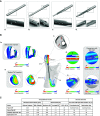Central Venous Catheter Malfunction in Children: A Bioengineering Approach
- PMID: 35817475
- PMCID: PMC9625107
- DOI: 10.2215/CJN.01470222
Central Venous Catheter Malfunction in Children: A Bioengineering Approach
Keywords: bioengineering; catheter design; computational fluid dynamics; dialysis access; hemodialysis access; pediatric catheters performance; pediatric nephrology; vascular access.
Figures

References
-
- Shroff R, Calder F, Bakkaloğlu S, Nagler EV, Stuart S, Stronach L, Schmitt CP, Heckert KH, Bourquelot P, Wagner AM, Paglialonga F, Mitra S, Stefanidis CJ; European Society for Paediatric Nephrology Dialysis Working Group : Vascular access in children requiring maintenance haemodialysis: A consensus document by the European Society for Paediatric Nephrology Dialysis Working Group. Nephrol Dial Transplant 34: 1746–1765, 2019 - PubMed
-
- Borzych-Duzalka D, Shroff R, Ariceta G, Yap YC, Paglialonga F, Xu H, Kang HG, Thumfart J, Aysun KB, Stefanidis CJ, Fila M, Sever L, Vondrak K, Szabo AJ, Szczepanska M, Ranchin B, Holtta T, Zaloszyc A, Bilge I, Warady BA, Schaefer F, Schmitt CP: Vascular access choice, complications, and outcomes in children on maintenance hemodialysis: Findings from the International Pediatric Hemodialysis Network (IPHN) Registry. Am J Kidney Dis 74: 193–202, 2019 - PubMed
-
- Park MH, Qiu Y, Cao H, Yuan D, Li D, Jiang Y, Peng L, Zheng T: Influence of hemodialysis catheter insertion on hemodynamics in the central veins. J Biomech Eng 142: 091002, 2020 - PubMed
-
- Mareels G, Kaminsky R, Eloot S, Verdonck PR: Particle image velocimetry-validated, computational fluid dynamics-based design to reduce shear stress and residence time in central venous hemodialysis catheters. ASAIO J 53: 438–446, 2007 - PubMed
Publication types
MeSH terms
Grants and funding
LinkOut - more resources
Full Text Sources

